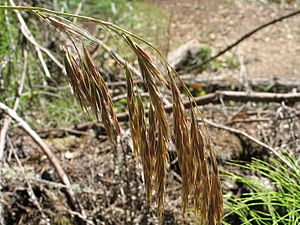Chinook brome facts for kids
Quick facts for kids Chinook brome |
|
|---|---|
 |
|
| Scientific classification | |
| Genus: |
Bromus
|
| Species: |
laevipes
|
Bromus laevipes is a type of grass often called Chinook brome. It belongs to a group of grasses known as brome grasses.
This plant grows naturally in western North America. You can find it from the state of Washington all the way down to Baja California in Mexico. It is quite adaptable and can grow in many different kinds of places.
What is Chinook Brome?
Chinook brome is a plant that lives for more than two years. This means it doesn't die after one growing season like some other plants. It can grow quite tall, sometimes reaching over 1.5 meters (about 5 feet) high!
What Does it Look Like?
The leaves of the Chinook brome can be wide, almost 2 centimeters (about 0.8 inches) across at their base.
The plant produces flowers and seeds in a special cluster called an inflorescence. This cluster is open and spread out. The lower parts of these clusters often hang down or nod gently.
The small parts that make up the flower cluster are called spikelets. These spikelets are usually flattened and can feel a bit hairy or soft to the touch.
Where Does Chinook Brome Grow?
This grass is native to a large area in western North America. Its natural home stretches from the state of Washington in the north, through Oregon, California, and into the Baja California peninsula in Mexico.
It can be found in many different environments. This includes various types of habitats, showing how tough and adaptable this grass can be.
See also
 In Spanish: Bromus laevipes para niños
In Spanish: Bromus laevipes para niños

